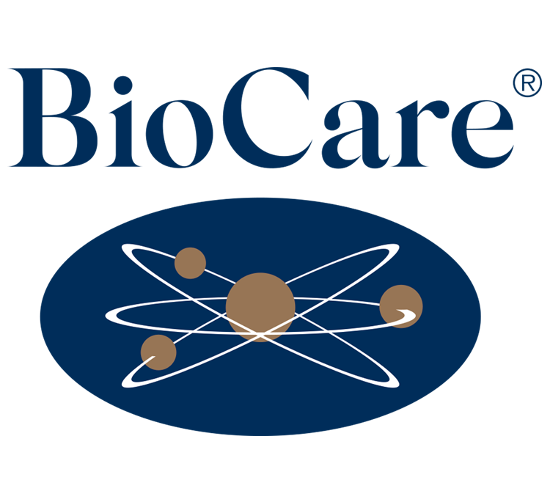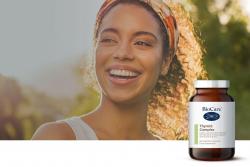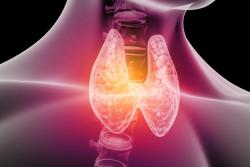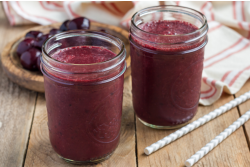If you are already going through menopause, you might have already observed its impact on your joints, bones and skin. Alternatively, if you are in your late 40s or 50s and preparing for this stage, you may be familiar with common symptoms associated with menopause, such as hot flushes or mood swings. However, did you know that a drop in sex hormones can have a significant impact on your bone density, skin quality and joint health? During this stage of life, the ovaries cease their activity, and there[KS1] is a decrease in female hormones, particularly progesterone and oestrogen. The hormonal fluctuations, especially the decline in oestrogen, have a notable impact on connective tissue health. Connective tissue, as the name indicates, connects, and supports various tissues and organs in the body, including cartilage, bones, and skin. Additionally, it plays a crucial role in maintaining proper body posture and providing structural support.
How can hormonal changes around menopause influence skin quality?
Have you noticed any changes in the texture and elasticity of your skin? Reduced oestrogen levels can decrease collagen production (1), contributing to changes in skin quality such as elasticity and hydration or the development of wrinkles, for instance. In fact, you may have heard about collagen from face cream adverts, but it does much more than wrinkle prevention! Although we can buy collagen in powders or supplements, it is not guaranteed that it will be used properly in the body because it is quite a big molecule, and it gets broken down in the stomach, rendering it less useful. That’s why getting the right type of collagen is important.
Marine Collagen provides type I collagen, which displays high resemblance with human collagen and, therefore, is easily absorbed through the gut wall and quickly delivered to the target tissues.2 It can improve skin elasticity (2), hydration and reduce the appearance of wrinkles (3). Another key molecule involved in skin moisture is Hyaluronic acid, which is found at high concentrations in different types of connective tissue, including muscles, cartilage and all layers of the skin. This viscous substance can improve skin hydration4, has a vital protective role and enables nutrient delivery and excretion of waste.
How does a decline in oestrogen affect my joints?
Have you noticed unexplained joint pain and stiffness? Connective tissue, like ligaments and tendons, rely on adequate oestrogen levels for proper functioning. Oestrogen can also influence collagen synthesis which is a major component of joints. Diminished production of collagen can contribute to the breakdown of the joint cartilage and decrease the elasticity and flexibility of the joints, leading to joint pain and decreased overall motility (5). In some cases, degradation of the joint cartilage can contribute to the condition called osteoarthritis. Hence why, adequate collagen intake during menopause is essential. Marine collagen can improve joint function and reduce pain and potentially reduce joint inflammation (6). However, the main collagen in the cartilage is Collagen type II, consisting of 95% of all collagen types.7 It has a similar molecular structure to type I collagen, but has a different chain composition (8).
Studies have shown that type II collagen can support joint health, stiffness,mobility (5), and flexibility (9) as well as decrease joint inflammation and pain in osteoarthritis (10).
However, collagen is not the only powerful nutrient to support our joints. For instance, glucosamine, sulphur from Methyl Sulphonyl Methane (MSM) and chondroitin are very effective in supporting joint and overall connective tissue, especially if administered in combination. Glucosamine is a key component of synovial and bursal fluid, connective tissues, mucous membranes, ligaments and tendons. It can prevent joint degradation by providing the body with materials needed to build and repair cartilage and improve the flexibility and strength of the joint tissue (11).
MSM is a natural substance found in sulphur bearing foods such as cruciferous vegetables, garlic, fatty fish, legumes, meat, eggs or sunflower seeds. Sulfur is an essential mineral that plays a role in various bodily functions, including the formation of proteins and connective tissues. It can improve pain and the functional ability of the joints (12). Chondroitin is another naturally occurring substance in connective tissue which cushions joints and provides structural support to various parts of the body, including ligaments and tendons (13).
Reducing inflammation for healthier joints
Inflammation is what causes pain and swelling, and if it’s chronic, it can significantly exacerbate joint degradation and inhibit natural healing processes. To reduce inflammation, include plenty of ant-inflammatory foods in your diet. These include oily fish (mackerel, sardines, wild salmon), which contain high levels of omega 3-fats, EPA and DHA, herbs and spices, especially turmeric, ginger, cinnamon, rosemary, sage and fruit and vegetables, particularly green leafy and cruciferous vegetables and berries.
Supplementation with fish oils can significantly reduce the production of inflammatory molecules in the body and has been shown to reduce joint stiffness and pain (14). Fish oil also increases collagen synthesis (15).
Plant chemicals such as curcumin, turmeric or proanthocyanidins from pine bark or Boswellia also have potent anti-inflammatory and pain-lowering properties (16–18).
Supporting collagen synthesis naturally
Hormonal changes during menopause are not the only factors affecting collagen synthesis. Different environmental factors such as smoking or poor diet would also have an impact. While bone broth, made from animal bones and connective tissues, can contribute to overall collagen intake, there are several steps and enzymatic processes in collagen synthesis, and those processes require vitamin C. Thus, adequate supply of vitamin C from supplements and foods such as citrus fruits, and berries can support our body’s ability to produce collagen. Consuming a good amount of protein from various sources also supports collagen synthesis (19). Our body produces collagen by breaking down dietary protein into amino acids, which are then used as building blocks to form long, robust structures. Other factors that can support collagen production include proper hydration, avoiding excessive sunshine exposure and quitting smoking. Ingestion of chemicals through exposure to cleaning products, mould, toxins, and cigarette smoke can also damage the cells responsible for the production and breakdown of collagen. Managing stress and inflammation is also critical to help maintain the health of the cells involved in collagen production.
Why are my bones and muscles painful, and I’m more prone to fractures?
Do you feel like your muscles are more sore than they used to be? Perhaps you’ve developed a higher susceptibility to injuries? Oestrogen plays a significant role in maintaining bone density and calcium absorption in the intestines (20). The decline in this hormone can contribute to decreased bone density, increased muscle aches, and overall weakness. Accelerated bone loss can also make women more susceptible to osteopenia and, in more severe cases, osteoporosis. Significantly decreased bone density in those conditions can lead to an elevated risk of fractures.
Fueling strong muscles and bones
If there is a risk of osteoporosis, for example due to family history, avoiding certain foods that promote calcium excretion or blocks mineral uptake is important. This includes excessive salt, sugar, and caffeine. Also, the phosphates in soft drinks block the uptake of calcium. Caffeine upsets the normal balance of calcium and phosphorous, causing increased calcium to be excreted in urine (21). Increasing calcium-rich foods such as dairy products, leafy green vegetables (kale, broccoli), almonds, sesame seeds and fortified plant-based milk.
While calcium is fundamental for bone health, the story is incomplete without considering the role of other synergetic nutrients. Vitamin K is needed to utilise calcium properly and to prevent calcium deposition in soft tissues such as blood vessels. Vitamin K can prevent bone degradation and promote bone mineralisation (22). Dietary sources of vitamin K include green leafy vegetables such as kale, broccoli or spinach, fermented foods such as natto (fermented soybeans).
Vitamin D also plays a vital role in overseeing the utilisation of calcium and is crucial for muscle function. Sunlight exposure is a great way of getting vitamin D, and although some foods such as fatty fish (salmon, mackerel) and egg yolks contain this nutrient, we can’t get enough vitamin D from the diet, and supplementation might be essential, especially throughout the winter. In order to establish an adequate dose, we recommend testing your levels with an At-Home Test.
Boron plays a significant role, by assisting the conversion of vitamin D to its active form and helping in the formation of oestrogen.23 Studies show that supplementing boron can reduce urinary calcium excretion by 44% (24).
Magnesium is needed for bone growth, calcium absorption and assimilation. If the body has too little magnesium, it may ‘misplace’ calcium in tissues and organs, i.e. muscles, heart, and kidneys. Magnesium also helps with muscle contraction and relaxation. The recommended ratio between calcium and magnesium varies, but is probably in the region of 1:1 or 2:1 calcium to magnesium. Magnesium-rich foods include nuts, seeds, whole grains, and leafy green vegetables.
Regular exercise, including weight-bearing exercises and strength training, is also crucial for overall connective tissue including bone and muscle health. Additionally, managing stress is crucial since cortisol, our stress hormone, causes calcium to be pulled from the bones (25).
Menopause is related to hormonal changes in the body, which can affect connective tissue health. While this hormonal shift can contribute to different symptoms, there is a lot you can do to support your connective tissue and overall health during this transformative phase. This includes making sure you supply your body with all the essential nutrients from diet and supplements. Certain lifestyle adjustments, including regular physical activity, allow you to enjoy this wiser stage of life with more energy and greater ease and confidence.
References:
1. Shah MG, Maibach HI. Estrogen and skin. An overview. Am J Clin Dermatol. 2001;2(3):143-150. doi:10.2165/00128071-200102030-00003
2. rong Pei X, yue Yang R, feng Zhang Z, et al. [Effects of marine collagen peptide on delaying the skin aging]. Zhonghua Yu Fang Yi Xue Za Zhi. 2008;42(4):235-238. https://pubmed.ncbi.nlm.nih.gov/18763632/
3. Evans M, Lewis ED, Zakaria N, Pelipyagina T, Guthrie N. A randomized, triple-blind, placebo-controlled, parallel study to evaluate the efficacy of a freshwater marine collagen on skin wrinkles and elasticity. J Cosmet Dermatol. 2021;20(3):825-834. doi:10.1111/JOCD.13676
4. Papakonstantinou E, Roth M, Karakiulakis G. Hyaluronic acid: A key molecule in skin aging. Dermatoendocrinol. 2012;4(3):253. doi:10.4161/DERM.21923
5. Harris RB, Fonseca FLA, Sharp MH, Ottinger CR. Functional Characterization of Undenatured Type II Collagen Supplements: Are They Interchangeable? https://doi.org/101080/1939021120211931621. 2021;19(6):717-732. doi:10.1080/19390211.2021.1931621
6. Geahchan S, Baharlouei P, Rahman MA. Marine Collagen: A Promising Biomaterial for Wound Healing, Skin Anti-Aging, and Bone Regeneration. Mar Drugs. 2022;20(1). doi:10.3390/MD20010061
7. Gudmann NS, Karsdal MA. Type II Collagen. Biochemistry of Collagens, Laminins and Elastin: Structure, Function and Biomarkers. Published online August 15, 2016:13-20. doi:10.1016/B978-0-12-809847-9.00002-7
8. Collagen Type 2 - an overview | ScienceDirect Topics. Accessed September 7, 2023. https://www.sciencedirect.com/topics/nursing-and-health-professions/collagen-type-2
9. Bakilan F, Armagan O, Ozgen M, Tascioglu F, Bolluk O, Alatas O. Effects of Native Type II Collagen Treatment on Knee Osteoarthritis: A Randomized Controlled Trial. Eurasian J Med. 2016;48(2):95. doi:10.5152/EURASIANJMED.2015.15030
10. Orhan C, Juturu V, Sahin E, et al. Undenatured Type II Collagen Ameliorates Inflammatory Responses and Articular Cartilage Damage in the Rat Model of Osteoarthritis. Front Vet Sci. 2021;8:617789. doi:10.3389/FVETS.2021.617789/BIBTEX
11. Tiku ML, Narla H, Jain M, Yalamanchili P. Glucosamine prevents in vitro collagen degradation in chondrocytes by inhibiting advanced lipoxidation reactions and protein oxidation. Arthritis Res Ther. 2007;9(4):R76. doi:10.1186/AR2274
12. Usha PR, Naidu MUR. Randomised, Double-Blind, Parallel, Placebo-Controlled Study of Oral Glucosamine, Methylsulfonylmethane and their Combination in Osteoarthritis. Clin Drug Investig. 2004;24(6):353-363. doi:10.2165/00044011-200424060-00005
13. Zeng C, Wei J, Li H, et al. Effectiveness and safety of Glucosamine, chondroitin, the two in combination, or celecoxib in the treatment of osteoarthritis of the knee. Sci Rep. 2015;5(1):16827. doi:10.1038/srep16827
14. Kostoglou-Athanassiou I, Athanassiou L, Athanassiou P. The Effect of Omega-3 Fatty Acids on Rheumatoid Arthritis. Mediterr J Rheumatol. 2020;31(2):190. doi:10.31138/MJR.31.2.190
15. Hankenson KD, Watkins BA, Schoenlein IA, Allen KGD, Turek JJ. Omega-3 fatty acids enhance ligament fibroblast collagen formation in association with changes in interleukin-6 production. Proc Soc Exp Biol Med. 2000;223(1):88-95. doi:10.1046/J.1525-1373.2000.22312.X
16. Hewlings S, Kalman D. Curcumin: A Review of Its Effects on Human Health. Foods. 2017;6(10):92. doi:10.3390/foods6100092
17. Cisár P, Jány R, Waczulíkova I, et al. Effect of pine bark extract (Pycnogenol) on symptoms of knee osteoarthritis. Phytother Res. 2008;22(8):1087-1092. doi:10.1002/PTR.2461
18. Yu G, Xiang W, Zhang T, Zeng L, Yang K, Li J. Effectiveness of Boswellia and Boswellia extract for osteoarthritis patients: a systematic review and meta-analysis. BMC Complement Med Ther. 2020;20(1). doi:10.1186/S12906-020-02985-6
19. Holwerda AM, Van Loon LJC. The impact of collagen protein ingestion on musculoskeletal connective tissue remodeling: a narrative review. Nutr Rev. 2022;80(6):1497. doi:10.1093/NUTRIT/NUAB083
20. Nie X, Jin H, Wen G, et al. Estrogen Regulates Duodenal Calcium Absorption Through Differential Role of Estrogen Receptor on Calcium Transport Proteins. Dig Dis Sci. 2020;65(12):3502-3513. doi:10.1007/S10620-020-06076-X
21. Massey LK, Whiting SJ. Caffeine, urinary calcium, calcium metabolism and bone. J Nutr. 1993;123(9):1611-1614. doi:10.1093/JN/123.9.1611
22. Vitamin K. J Am Med Assoc. 1939;113(5):417. doi:10.1001/jama.1939.02800300047014
23. Nielsen FH, Hunt CD, Mullen LM, Hunt JR. Effect of dietary boron on mineral, estrogen, and testosterone metabolism in postmenopausal women1.
24. Pizzorno L. Nothing boring about boron. Integrative Medicine (Boulder). 2015;14(4):35-48. /pmc/articles/PMC4712861/
25. Mathis SL, Farley RS, Fuller DK, Jetton AE, Caputo JL. The Relationship between Cortisol and Bone Mineral Density in Competitive Male Cyclists. Journal of Sports Medicine. 2013;2013:1-7. doi:10.1155/2013/896821






